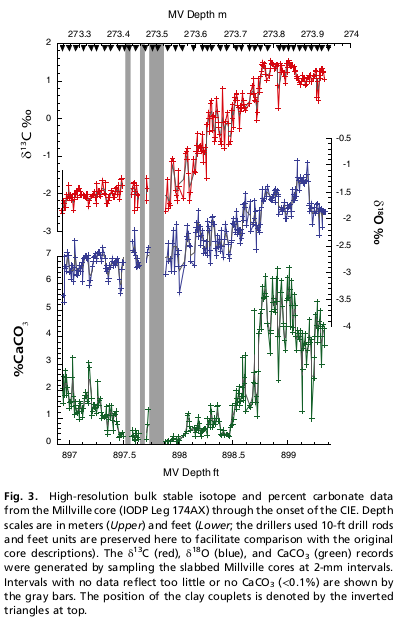
The Paleocene to Eocene Thermal Maximum was 55 million years ago, when a great deal of carbon was released into the atmosphere. It seems this happened very quickly, possibly within one year, as the link below argues.
http://www.pnas.org/content/110/40/15908
The paper analyzes sediment cores from New Jersey which was around 35N back in the day, and finds layers innit. The layers exhibit variations in concentration of O-18 isotope which the authors attribute to annual freshwater flux and annual temperature variation. So the layers seem to be annual.
But wait, there's more.
Examining the layers closely, they see decreases in calcium carbonate (CaCO3) concentration and isotope C-13 concentration at PETM. The CaCO3 drops faster than the C-13. This is to be expected based on a model by David Archer. And this model, together with the evidence is further evidence the layers are annual.

But wait, there's more.
The speed of CaCO3 decrease is astonishing, " ... %CaCO3 shows a more abrupt decrease, from 6% to 1% within one layer." Acidification occurred in an eyeblink. “Precipitous” is the term the authors use.
They estimate 3000 GT carbon release: "Given the rapidity of the onset, magnitude of the delta-C13 excursion, and that the observed calcite compensation depth shoaling in deep ocean requires approx. 3,000 GtC(3), two mechanisms meet these criteria: large igneous province-produced thermogenic methane (6, 7) and cometary carbon (11,12). The latter is consistent with the recent discovery of a substantial accumulation of nonbiogenic magnetic nanoparticles in the Marlboro clay, whose origin is best ascribed to impact condensate (71)."
But wait, there's more.

Fig. 4 shows the effect of ocean depth of sediment deposition upon the size of the delta-C13 excursion.
This is very nice becoz it shows a path to reconcile deep and shallow sediment records from PETM. The deep ocean equilibrates slower than shallow ocean, and the peak size is attenuated in comparison.
The good part, if you can call it "good", is that carbon load at PETM was apparently injected faster than we are currently doing. (We have put in 500 gigaton so far, since the Industrial revolution, and probably will put in at least 500 gigaton more. So maybe, the effects will be smaller than the PETM. But climate system is different now, we are in an interglacial, feedbacks are different, the situation remains dangerous.